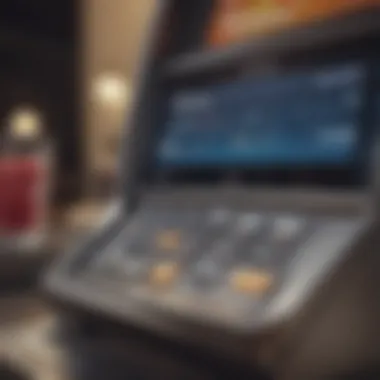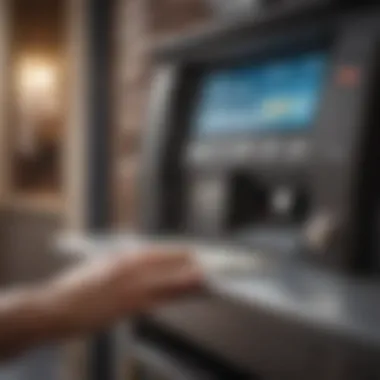Understanding Overdrafting: Chase ATM Policies Explained


Intro
Overdrafting is an essential concept for anyone managing a bank account, especially when it involves an ATM. Chase, one of the largest banks in the U.S., allows customers to access their funds conveniently. However, this comes with certain risks, particularly when account balances dip below zero. Understanding how overdrafts work in relation to your Chase account at an ATM is critical for effective financial management. You need to be aware of the policies and potential fees that could arise from overdrafting. This article will guide you through the details, empowering you with the knowledge to make informed decisions.
Understanding Overdrafting with Chase
Overdrafting occurs when you attempt to withdraw more money than is available in your account. Chase provides overdraft protection in certain situations, which is an important aspect to consider. The first step is to understand how this policy functions and its implications on your account.
Chase's Overdraft Policy
Chase has specific rules surrounding overdrafts. Key points include:
- Overdraft Protection: This feature, when enabled, covers transactions that exceed your balance, up to a set limit.
- Fees: Typically, Chase may charge fees for overdrafts that can accumulate quickly. Understanding this can help you avoid surprise charges.
- ATM Transactions: Initial attempts to use an ATM with insufficient funds may decline; however, further overdrafting could occur based on your account settings.
It is critical to familiarize yourself with these features to avoid financial pitfalls.
Implications of Using an ATM with Low Balances
Attempting to access cash via an ATM when your account balance is low can have several implications. If your overdraft protection is activated, you may be able to withdraw money even if your account is overdrawn. It is necessary to consider the following:
- Potential Fees: Each overdraft may incur a fee that can impact your balance significantly.
- Credit Impact: Frequent overdrafting might affect how lenders view your credit worthiness.
Managing Low Balances
To avoid overdrafting your Chase account, here are some strategies:
- Regular Balance Checks: Make it a habit to check your balance frequently.
- Set Up Alerts: Use the Chase mobile app to set balance alerts.
- Budgeting: Maintain a strict budget to prevent excess spending.
These actions can help improve your financial situation and prevent unnecessary fees associated with overdrafts.
The End
Navigating the intricacies of overdrafting requires understanding the specific policies of your bank. Chase offers mechanisms for managing overdrafts, but awareness of the associated fees and implications is key. Implementing strategies for maintaining your balance will empower you to make smarter financial choices and protect your account health.
Prolusion to Overdrafting
Overdrafting is a financial concept that occurs when an account holder withdraws more money than is available in their checking account. This situation can happen unexpectedly, leading to various implications for the account holder. Understanding overdrafting is crucial, especially for those who might rely on ATMs for cash withdrawals. This article will delve into the nuances of overdrafting a Chase account at an ATM, highlighting essential policies and protections regarding this practice.
Recognizing the significance of overdrafting is important for several reasons. First, it affects one’s financial health and can lead to excessive charges if not managed properly. Many account holders overlook the risks associated with overdrawing their accounts. This oversight can result in unexpected overdraft fees, which can accumulate quickly. Chase Bank, like many institutions, has specific overdraft policies that account holders must understand.
Additionally, managing an account effectively involves knowing how overdraft protection features can mitigate risks. Customers might find themselves questioning, "Can I still access my funds at an ATM even with an overdrawn balance?" Addressing this question is essential for maintaining financial stability and making informed decisions regarding cash withdrawal practices.
In this article, we will explore Chase's policies and how they relate to overdrafting at ATMs. This investigation will culminate in providing practical strategies to better manage your account and minimize the likelihood and impact of overdrafts. Understanding the mechanics behind overdrafting is not merely an academic exercise; it is a necessary skill for securing one’s financial future.
Overview of Chase Bank Policies


Understanding the policies of Chase Bank is essential for managing any account. These policies govern how Chase handles overdrafts, and knowing them can offer significant benefits for account holders. First, familiarize yourself with the specific rules and regulations of the bank. This knowledge is essential in preventing unintentional overdrawing and the resulting fees.
Understanding Overdraft Policies
Chase Bank's overdraft policy is crucial for account holders. It delineates how transactions are processed when the balance falls below zero. Under normal circumstances, Chase offers several services designed to manage overdraft occurrences. The first aspect to consider is the distinction between overdraft and insufficient funds fees. Using an ATM when the balance is low may trigger one of these fees if the account does not have protective measures in place.
In addition, Chase usually covers certain transactions even if the account has insufficient funds, meaning you can still access funds up to a defined limit. This offers some flexibility but also carries financial responsibilities. To avoid accruing excessive fees, learn about your current balance and available funds before making withdrawals or payments.
Chase Overdraft Protection Options
Chase provides several options for overdraft protection, which can minimize the impact of overdrawing your account. One approach is to link a savings account to the checking account. This means that if your checking account balance drops too low, Chase can automatically transfer funds from your linked savings account to cover the shortfall.
- Another option is setting up a line of credit. If your checking balance goes negative, the line of credit can be tapped to cover transactions, ensuring you are less likely to incur fees for overdrafts.
- Overdraft protection comes with its considerations. Some fees still apply, but they are often lower than standard overdraft charges.
By understanding and utilizing these protection options, you can improve your financial management. Make sure to carefully read the terms and conditions associated with each option for a clear picture of how they affect your account.
Can You Overdraft at an ATM?
The question of whether one can overdraft an account at an ATM is essential for anyone managing a Chase account. Understanding this concept is not just about knowing the rules. It involves grasping the potential ramifications that come with withdrawing funds beyond your available balance. Overdrafting can lead to financial strain and unexpected fees. Therefore, it is crucial to be informed about the specifics related to ATM transactions.
When an individual attempts a withdrawal at an ATM with an insufficient balance, the transaction's outcome can vary. Factors like overdraft protection and available limits will play a vital role in determining whether the withdrawal will go through. This section will clarify the mechanics of overdrafts specifically related to ATM usage, emphasizing the necessity for awareness.
ATM Withdrawal Limits with an Overdrawn Account
When attempting to withdraw cash from an ATM with an overdrawn Chase account, the limiting factors include daily withdrawal limits and the nature of the account's overdraft protection.
Chase accounts generally have a maximum daily withdrawal limit that varies based on account type. If your account is enrolled in the overdraft protection service, you may be able to withdraw funds exceeding your balance. This overdraft limit is distinct from your regular withdrawal limit and typically cap at a specific amount. Ultimately, the total amount available for withdrawal will depend on these stipulated limits.
To avoid surprises, it is wise to check your account details regarding withdrawal limits and account settings. Knowing this information can help in planning withdrawals better.
Factors Affecting Overdrafting at an ATM
Several factors contribute to the possibility of overdrafting at Chase ATMs.
- Account Settings: The type of account and its specific settings drastically influence your overdraft options. Some accounts come by default with overdraft protection, while others do not.
- Transaction Amount: The total amount you wish to withdraw plays a significant role. If your request exceeds your overdraft limit, the transaction will not go through.
- Timing of the Transaction: Transactions processed at different times of the day may have varying outcomes. If your account is already overdrawn at the time you request a withdrawal, it could impact your ability to complete that transaction.
- Current Bank Policies: Chase's policies and practices regarding overdrafts at ATMs may evolve over time. Checking for any updates can keep you informed about your account’s status.
In summary, understanding these factors provides clarity on your capabilities when using ATMs for withdrawals. They inform your decision-making process and may prevent inadequate withdrawals in the future.
Maintaining a clear understanding of account details and overdraft policies can significantly impact financial health. It is a strategy worth embracing.
Potential Fees Involved
Understanding the potential fees involved in overdrafting a Chase account can greatly impact your financial health. Fees can accrue quickly, and being well-informed allows you to anticipate costs and manage your finances more effectively. Chase Bank has various policies concerning overdraft fees. Knowing these fees can help you avoid unnecessary expenses and take proactive steps to maintain a positive account balance.
Chase Overdraft Fees
Chase Bank charges an overdraft fee of up to $34 for each transaction that overdraws your account. This means that if you attempt to make multiple transactions without sufficient funds, you could face multiple fees. For instance, if you overdraft your account three times in one day, you might incur three separate fees totaling up to $102. Notably, Chase typically authorizes the first transaction for the day if it exceeds your available balance, followed by subsequent transactions which may incur fees.


Additionally, it is worth mentioning that Chase has specific policies regarding daily fees. They limit the total fees to four per day. However, this cap does not lessen the impact these fees can have if they accumulate. More than emotional annoyance, overdraft fees can severely affect your financial planning and budgeting efforts. Thus, it’s essential to keep track of your spending to minimize the risk of overdrafting.
Other Related Fees
Apart from the overdraft fees, other charges may come into play if you go over your account balance. These fees can include:
- NSF (Non-Sufficient Funds) Fees: When a transaction cannot be completed due to insufficient funds, Chase may charge you an NSF fee, which can also be around $34 per transaction.
- Return Item Fees: If a transaction is returned due to insufficient funds, you could incur an additional fee of similar amounts.
- Payment Declines: If you try to make a purchase for which you do not have enough funds, the merchant may charge you a fee for a declined payment, although this is more contingent on the merchant’s policies.
These additional fees can compound the original overdraft fee and create a significant financial burden. Therefore, understanding these potential fees is vital for anyone managing a Chase account. By recognizing the types of fees associated with overdrawing, you can develop a better strategy to maintain financial health.
In summary, being aware of the fees associated with overdrafting at Chase is crucial for effective financial management. It can guide your spending decisions and push you toward more responsible account management.
Alternatives to Overdrafting
Managing your finances effectively is critical, especially when it comes to avoiding overdrafts. This section presents various alternatives to overdrafting that can help you maintain a healthy account balance. Implementing these strategies can not only prevent overdraft fees but also strengthen your overall financial situation. Understanding these options can lead to better financial decisions and empower you to manage your funds more wisely.
Keeping a Buffer in Your Account
One of the simplest ways to avoid overdrafting is by keeping a buffer in your Chase account. This buffer is a small amount of money deliberately left unspent. It serves as a financial cushion in case unexpected expenses arise or if you accidentally overspend.
For example, if you typically maintain a balance of $500, consider setting a personal limit of $450. This way, when you do make purchases or withdraw cash, you will not risk going below your limit. A buffer provides peace of mind and can help you avoid fees associated with overdrafting. Here are some tips for maintaining a buffer:
- Assess your spending habits: Knowing your average expenditure can assist in determining an appropriate buffer amount.
- Predictable expenses: Take into account recurring bills and anticipate when these payments will occur.
- Consistent monitoring: Review your account regularly to ensure the buffer is still adequate.
Using a Linked Savings Account
Another effective method to prevent overdrafts is to utilize a linked savings account. By connecting your Chase checking account to a savings account, you can set up automatic transfers that will kick in if your checking account balance falls below a designated level. This safeguard ensures funds are available for withdrawals and expenditures without incurring overdraft fees.
Some key points about linked savings accounts include:
- Automatic transfers: Set up your Chase account to automatically move money from the savings to checking when the checking account balance is below a certain threshold.
- Flexible amounts: You can tailor how much money gets transferred depending on your financial situation.
- Earning interest: Funds in a savings account can generate interest, providing an additional benefit.
Setting Up Alerts for Low Balances
Implementing alerts for low account balances can significantly assist in managing your finances effectively. Chase offers various alert options that notify you when your balance hits a specific point, allowing you to address the situation promptly.
- Customizable alerts: Tailor alerts based on your needs. You can choose to be notified daily, weekly, or whenever your account drops below a certain amount.
- Timely notifications: Get alerted via SMS or email, ensuring you receive instant updates about your financial standing.
- Proactive management: With alerts in place, you can take immediate action, such as transferring funds from another account or adjusting your spending habits.
Setting these alerts empowers you to stay informed about your account status and helps you avoid overdrafts.
In summary, employing these alternatives to overdrafting can enhance your financial control. Keeping a buffer, utilizing a linked savings account, and establishing alert systems are practical strategies that can lead to better financial health and decreased reliance on overdrafting your Chase account.
Implications of Overdrafting
Overdrafting can have significant implications for account holders, particularly for those with Chase accounts. Understanding these implications is essential for making informed financial decisions. When an account goes overdrawn, it is more than just a momentary lapse in balance; it can affect the user's financial health, credit worthiness, and relationship with the bank. With proper awareness and management, the consequences of overdrafting can be mitigated, allowing individuals to maintain control over their finances.


Impact on Credit Score
One critical aspect of overdrafting is its potential impact on one's credit score. Although Chase does not report overdraft occurrences directly to credit bureaus, a prolonged negative balance can lead to account closure or collections. This can leave a mark on a person’s credit report. Factors related to overdrafting that could negatively affect a credit score include:
- Unpaid Fees: If overdraft fees accumulate and remain unpaid, they may result in collections.
- Account Closure: If an account is closed due to excessive overdrafts, it can impact the credit history, especially if left unresolved.
Monitoring account balances and proactively addressing any overdrafts can help individuals avoid these credit-related pitfalls.
Customer Relationship with Chase Bank
The way overdrafts are handled can also influence a customer's relationship with Chase Bank. A history of frequent overdrafts may raise concerns about a customer’s financial habits. Banks may reevaluate the terms of services offered, such as overdraft protection, based on account activity. Factors to consider include:
- Access to Credit: Continued overdrafting might jeopardize the chances of obtaining a future loan or line of credit.
- Service Limitations: Frequent overdrafts could result in limits on services or restrictions on accounts offered by Chase.
Establishing a strong banking relationship is beneficial, and managing overdrafts wisely is a critical step in fostering this relationship. Proactive financial management contributes positively to both the financial standing of the account holder and their standing with the bank.
In summary, the implications of overdrafting are far-reaching. While it may seem a minor issue, understanding its potential effects on credit score and the bank-customer relationship is vital. Decision-making that incorporates overdraft risks can promote better financial outcomes.
Best Practices for Account Management
Managing your finances effectively is key to avoiding overdrafts and ensuring your account remains in good standing. Best practices for account management involve remaning vigilant about your financial situation. This can minimize the risks associated with overdrafting your Chase account, particularly at ATMs where transactions occur quickly.
Regular Account Monitoring
Regular account monitoring plays a crucial role in financial health. Keeping track of your account balance helps you be aware of your spending habits, understand cash flow, and stay within your budget. It prevents surprises during transactions.
- Use mobile banking apps for real-time balance updates.
- Set aside time every week to review your account.
- Check for pending transactions that may not yet be reflected in your balance.
These simple practices can help circumvent overdraft issues. The immediacy of technology allows you to access balances quickly, giving you the ability to react promptly to avoid overdrafts. Monitoring allows for better planning of withdrawals around expected inflows, making it easier to manage your money wisely.
Understanding Your Statements
Another vital aspect of financial management is understanding your statements. Bank statements include information on deposits, withdrawals, and fees that have been charged. A clear grasp of these details can aid in tracking spending patterns and identifying discrepancies.
- Pay attention to recurring charges and subscription services that may impact your balance.
- Review any fees associated with overdrafts or transactions at ATMs to stay informed.
- Look for patterns in spending that might indicate where you can save money.
By being vigilant about your statements, you can ensure that every transaction aligns with your financial goals. This proactive approach to understanding your financial documents prevents unexpected overdrafts and helps you maintain a healthier financial state.
“Staying on top of your finances requires diligence and organization. Best practices can save you money and prevent fees.”
Finale
In concluding this exploration of overdrafting a Chase account at an ATM, it is essential to highlight several key aspects. Overdrafting is not merely an inconvenience but a practice that can lead to significant financial implications, both immediate and long-term.
Understanding the specific policies of Chase Bank surrounding overdrafts is vital. Customers must be aware of what options ..are available, including overdraft protection. This knowledge is crucial for making informed decisions when facing low account balances.
The potential fees associated with overdrafts can impact one's financial health. Familiarity with these costs can help mitigate unexpected expenses, ultimately aiding in better budgeting practices.
Furthermore, adopting alternatives to overdrafting, such as maintaining a buffer in the account or leveraging a linked savings account, can enhance financial stability. Utilizing alert systems for low balances can also serve as a preventative measure against overdrafts.
By implementing best practices for account management, individuals can foster healthier financial habits. Regular monitoring of accounts and genuine understanding of monthly statements can facilitate early detection of spending patterns and potential overdraft scenarios.
Overall, this article aims to empower readers with a comprehensive understanding of overdrafting at Chase. Each element discussed contributes to a greater awareness of financial responsibility and effective management of one's finances. Taking these insights into account promotes not only better financial decision-making but also a more secure financial future.







